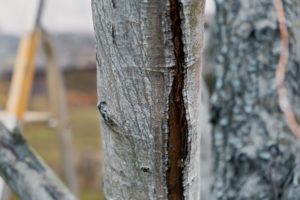
Learn what causes frost cracks in trees and how you can prevent them.
During the winter, trees are subjected to cold winter nights and sunny days and the temperature fluctuations that come with those changes. After moving between cold and warm temperatures every day, you may notice that your tree develops cracks – these are called frost cracks. These cracks can be up to several feet long and a few inches wide. The colder the temperatures, the wider the cracks may be. What do frost cracks do to your trees, and is there any way to prevent them? The tree care experts at Scientific Plant Service can help you understand this condition and what you may do about it.
How Are Frost Cracks Formed?
The term “frost cracks” refers to the vertical cracks created in a tree’s bark. Water expands as it freezes, and it is difficult for trees to tolerate the expansion that occurs when freezing water inside its bark melts and contracts as temperatures change. A crack may occur if the tree bark cannot withstand the expansion. Younger trees with thin bark are most susceptible to frost cracks. However, a tree that develops frost cracks is not in immediate danger and can live for many years.
The Threat of Sunscald
Freezing water and sap inside the tree’s wood is one potential cause of frost cracks. You might also see cracks develop due to “sunscald.” In late winter or early spring, the warmer afternoon sun shining on the tree trunk can cause the tissue to break dormancy. If sunny afternoons are followed by freezing nights, the newly awoken tissue and cells inside the tree can be damaged. If this happens, you may notice strips of bark peeling off the tree. Dark-colored and smooth-barked trees are most at risk for sunscald.
What Can You Do About Frost Cracks?
Is there a way to fix frost cracks once they appear? There is no way to bring the wood back together again once it is cracked. However, you can keep the crack clean to prevent infection. The tree often attempts to heal itself by forming a callus along the frost cracks. Because this crack provides an opening into the tree bark, it may become an entry point for pests. You should monitor the tree closely to catch any signs of pests before they overtake your tree.
How to Prevent Frost Cracks From Developing
You can prevent future frost cracks from forming by wrapping the tree trunk for the winter. Remove the wrap once temperatures warm up in late winter or spring because leaving the wrap on too long provides a hiding place for insects and disease organisms.
You may also protect your tree by planting evergreen shrubs around the trunk. These shrubs help protect the trunk from temperature extremes and shield it from the strongest afternoon sunlight.
High-value trees benefit from fertilization to help their overall health and combat damage from frost cracks. However, if you believe that your tree’s damage is severe, contact tree care professionals at Scientific Plant Service for an inspection before more damage may occur.
Scientific Plant Service Is Your Go-To Source In Landscape Healthcare
Scientific Plant Service, located in Baltimore, is a privately owned corporation, chartered in Maryland in 1957 by Frank J. Burke. We started as a full-service Arborists specializing in the care of shade trees and ornamental shrubs, but today we are a Lawn Care company that is a huge part of the community. From aquatic environments and snow management to deer and mole control, SPS has services tailored specifically for your lawn and landscape.
We offer services in Maryland, Washington, DC, and Virginia, including: Harford, Baltimore, Carroll, Frederick, Howard, Anne Arundel, Montgomery, Prince Georges, Talbot, Queen Anne’s, Calvert counties in MD, as well as Loudoun County, Fairfax County, Arlington, Alexandria, and Falls Church in VA. For more information, contact us online, or call us at 410-321-0970. Be sure to follow us on Facebook, Twitter, LinkedIn, Instagram, and Pinterest.

